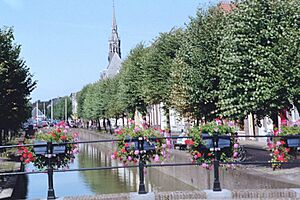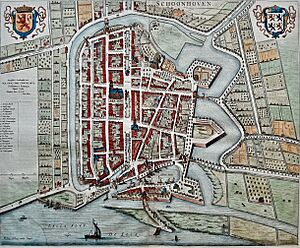Schoonhoven facts for kids
Quick facts for kids
Schoonhoven
|
|||
|---|---|---|---|
|
Town and former municipality
|
|||

Canal in Schoonhoven
|
|||
|
|||

Location in South Holland
|
|||
| Country | Netherlands | ||
| Province | South Holland | ||
| Municipality | Krimpenerwaard | ||
| Area | |||
| • Total | 6.92 km2 (2.67 sq mi) | ||
| • Land | 6.27 km2 (2.42 sq mi) | ||
| • Water | 0.65 km2 (0.25 sq mi) | ||
| Elevation | 3 m (10 ft) | ||
| Population
(2023)
|
13,570 | ||
| • Density | 1,898/km2 (4,920/sq mi) | ||
| Source: CBS, Statline. | |||
| Demonym(s) | Schoonhovenaar | ||
| Time zone | UTC+1 (CET) | ||
| • Summer (DST) | UTC+2 (CEST) | ||
| Postcode |
2870–2871
|
||
| Area code | 0182 | ||
Schoonhoven (Dutch pronunciation: [ˈsxoːnˌɦoːvə(n)]) is a town and former municipality in the western Netherlands, in the province of South Holland. Since 2015 it has been a part of the municipality of Krimpenerwaard, before it had been an independent municipality.
The former municipality had a population of 11,900 in 2014, and covered an area of 6.92 km2 (2.67 sq mi) of which 0.65 km2 (0.25 sq mi) water. From 2010 to 2014, it was the smallest municipality in the Netherlands in land area, following the merger of Rozenburg into Rotterdam.
The first winner of the Dutch version of Pop Idol, Jamai Loman, is from this town. Also Jan-Arie van der Heijden, football player for Feyenoord, lives in Schoonhoven.
History
c. 1220 a castle was built on the north side of a small stream called "Zevender", near its mouth at the Lek River. The town Schoonhoven was then formed near the castle. The oldest reference to the town is in a document from 1247, where it is referred to as Sconhoven. In 1280, it was granted town rights.
Around 1350, walls and gates were constructed around the town. The town's economy depended on shipping, brewing, fishing and agriculture. Schoonhoven was also the marketplace for the region. In 1518, the castle burned down and its remnants were removed in subsequent decades.
Between 1582 and 1601 the towm's defense walls were renewed and expanded to include the shipyards as well. At this point, the fortifications mainly faced eastward (as can be seen on the 1652 map of Schoonhoven by Joan Blaeu), because of the historically strategical location on the border between the County of Holland and the Bishopric of Utrecht. Following the Disaster Year of 1672, they were reinforced once again and expanded on the west and north sides. Yet in 1816, when bastion fortifications were no longer relevant to the warfare of the time, they were mostly demolished and made way for a cemetery and a park. Nowadays, most of the town walls and gates too have disappeared. The only remaining medieval entrance gate of Schoonhoven is the Veerpoort (Ferry Gate) that faces the Lek River. This Veerpoort has protected Schoonhoven from the floods of the river Rhine and from the sea during the devastating North Sea flood of 1953 and is still fully functional as a water barrier today.
By 1860, the town had 2900 inhabitants. Not until the middle of the 20th century did the town expand beyond the former fortress limits; firstly in a north-westerly direction, and then eastward since the 1990s.
Tourism and attractions
Schoonhoven is known for its silver and therefore carries the nickname: Zilverstad ("Silver Town"). Since the 17th century, silver and gold smiths have been working here. Today, Schoonhoven is still known for its silver. It is the host of "Het Nederlands Zilvermuseum" (the Dutch Silver Museum) and the International Silver School.
Schoonhoven is also known for is its production of clocks. There still is a variety of clock makers in Schoonhoven, some of which can be visited. A beautiful example of a large clockwork is the Van den Gheyn Beiaard in the tower of the medieval town hall of Schoonhoven.
The town is a popular stop for inland cruise ships, especially during the summer period. Tourists are often offered a guided tour of the town and its museums, or a relaxing cycling day trip through Schoonhoven's rural surroundings. The town is also popular among Dutch day-trippers and bicycle tourers. The grassy polders of the Krimpenerwaard, Lopikerwaard and Alblasserwaard surrounding the town of Schoonhoven are home to a magnificent variety of birds such as storks.
Popular events that take place in Schoonhoven include the annual well-visited Silver day (Zilverdag) on Whit Monday and "Spookhoven", a celebration of Halloween. Also, Koningsdag and the arrival of Sinterklaas are celebrated each year.
Schoonhoven has two main shopping streets with a variety of shops and boutiques. There are several restaurants and bars, as well as a hotel and a discotheque.
Transport
Schoonhoven lies in the middle of the Dutch Green Heart (Groene Hart), which is mostly a rural area with a relatively low population density. It therefore has no railway connection (although there was a tram connection with Gouda from 1914 until 1942, when it was broken up by the German Nazi authorities) and lacks a direct connection to a motorway. The town can be reached within half an hour from the major cities of Rotterdam and Utrecht via the N210 road, and from Gouda via the N207. It also has a frequent bus connection (lines 295 and 497) with these cities. Amsterdam is about an hour away by car.
A ferry transporting both vehicles and pedestrians across the Lek River connects Schoonhoven with Gelkenes in the municipality of Molenwaard. From here, the towns of Gorinchem, Dordrecht and Kinderdijk can each be reached within half an hour.
Gallery
-
Bartholomew church
Notable people
- Martin van Bruinessen
- Rick Karsdorp, Dutch professional footballer
- Olivier van Noort, the first Dutchman to circumnavigate the world. His statue can be found outside the ferry gate, overlooking the river.
Trivia
- Schoonhoven, being a fortified town, was part of the Old Hollandic Water Line.
See also
 In Spanish: Schoonhoven para niños
In Spanish: Schoonhoven para niños

















